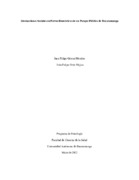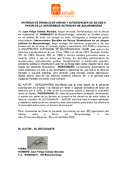Mostrar el registro sencillo del ítem
Interacciones sociales en perros domésticos de un parque público de Bucaramanga
| dc.contributor.advisor | Riveros Rodríguez, Juan Carlos | |
| dc.contributor.author | Gómez Morales, Juan Felipe | |
| dc.contributor.author | Ortíz Mojica, Iván Felipe | |
| dc.coverage.spatial | Bucaramanga (Santander, Colombia) | spa |
| dc.date.accessioned | 2022-06-17T19:58:00Z | |
| dc.date.available | 2022-06-17T19:58:00Z | |
| dc.date.issued | 2022-05 | |
| dc.identifier.uri | http://hdl.handle.net/20.500.12749/16732 | |
| dc.description.abstract | Estamos viviendo una transformación a nivel mundial con respecto a las relaciones entre seres vivos, cada vez son más las personas y familias que deciden tener una mascota en casa, en este caso específicamente, un perro doméstico. Las relaciones sociales han sido objeto de estudio en humanos y primates no-humanos mayormente, por lo cual existe relativamente poca documentación acerca de relaciones sociales en otras especies distintas al orden de los primates. En el caso de los perros domésticos, poco se ha documentado sobre la presencia de vínculos sociales, sin embargo, esto no implica la inexistencia de estos. Partiendo de lo anterior se ha realizado el ejercicio investigativo presentado en este documento, donde se caracteriza y evalúa el comportamiento social de los perros domésticos en un parque público en la ciudad de Bucaramanga y los factores influyentes en el comportamiento de estos. Se realizó la observación de un total de 40 perros domésticos. Dicha investigación se ha realizado con el objetivo de ampliar la literatura existente acerca de relaciones sociales entre perros domésticos, al describir las características del comportamiento canino, pretendiendo, además, aportando material para nuevas investigaciones y experiencias en el campo de la psicología animal. | spa |
| dc.description.tableofcontents | Resumen .......................................................................................................................................... 2 Abstract ............................................................................................................................................ 2 Introducción ..................................................................................................................................... 3 Justificación y Planteamiento del Problema .................................................................................... 4 Objetivos .......................................................................................................................................... 6 Objetivo general .......................................................................................................................... 7 Objetivos específicos ................................................................................................................... 7 Hipotesis .......................................................................................................................................... 7 Antecedentes de Investigación .................................................................................................... 8 Marco Teórico ............................................................................................................................... 12 Método ........................................................................................................................................... 15 Tipo de investigación ................................................................................................................. 15 Diseño ........................................................................................................................................ 15 Sujetos y lugar de estudio .......................................................................................................... 16 Instrumentos .............................................................................................................................. 16 Procedimiento ............................................................................................................................ 16 Resultados ...................................................................................................................................... 19 Discusión ....................................................................................................................................... 27 Conclusiones .................................................................................................................................. 32 Recomendaciones .......................................................................................................................... 33 Referencias .................................................................................................................................... 35 | spa |
| dc.format.mimetype | application/pdf | spa |
| dc.language.iso | spa | spa |
| dc.rights.uri | http://creativecommons.org/licenses/by-nc-nd/2.5/co/ | * |
| dc.title | Interacciones sociales en perros domésticos de un parque público de Bucaramanga | spa |
| dc.title.translated | Social interactions in domestic dogs in a public park in Bucaramanga | spa |
| dc.degree.name | Psicólogo | spa |
| dc.publisher.grantor | Universidad Autónoma de Bucaramanga UNAB | spa |
| dc.rights.local | Abierto (Texto Completo) | spa |
| dc.publisher.faculty | Facultad Ciencias de la Salud | spa |
| dc.publisher.program | Pregrado Psicología | spa |
| dc.description.degreelevel | Pregrado | spa |
| dc.type.driver | info:eu-repo/semantics/bachelorThesis | |
| dc.type.local | Trabajo de Grado | spa |
| dc.type.coar | http://purl.org/coar/resource_type/c_7a1f | |
| dc.subject.keywords | Psychology | spa |
| dc.subject.keywords | Public park | spa |
| dc.subject.keywords | Social relationships | spa |
| dc.subject.keywords | Canine behavior | spa |
| dc.subject.keywords | Social behavior | spa |
| dc.subject.keywords | Pets | spa |
| dc.subject.keywords | Domestic animals | spa |
| dc.subject.keywords | Deal with animals | spa |
| dc.subject.keywords | Social interaction | spa |
| dc.subject.keywords | Animal behavior | spa |
| dc.identifier.instname | instname:Universidad Autónoma de Bucaramanga - UNAB | spa |
| dc.identifier.reponame | reponame:Repositorio Institucional UNAB | spa |
| dc.type.hasversion | info:eu-repo/semantics/acceptedVersion | |
| dc.rights.accessrights | info:eu-repo/semantics/openAccess | spa |
| dc.relation.references | Aureli, F., Fraser, O., Schaffner, C. & Schino, G. (2012). Chapter 23 The Regulation of Social Relationships: . In J. Mitani, J. Call, P. Kappeler, R. Palombit & J. Silk (Ed.), The Evolution of Primate Societies (pp. 531-551). Chicago: University of Chicago Press. https://doi.org/10.7208/9780226531731-026 | spa |
| dc.relation.references | Kummer, H. (1978). On the value of social relationships to nonhuman primates: A heuristic scheme. Social Science Information, 17(4-5), 687–705. doi:10.1177/053901847801700418 | spa |
| dc.relation.references | Cords, M. (1997). Friendships, alliances, reciprocity and repair. In A. Whiten & R. Byrne (Eds.), Machiavellian Intelligence II: Extensions and Evaluations (pp. 24-49). Cambridge: Cambridge University Press. doi:10.1017/CBO9780511525636.003 | spa |
| dc.relation.references | White Mountain Group. (2020). LATINOAMÉRICA LÍDER EN EL CRECIMIENTO POBLACIONAL DE MASCOTAS. Obtenido de https://wmg-pet.com/latinoamerica lider-en-el-crecimiento-poblacional-de-mascotas/ | spa |
| dc.relation.references | Oropesa Roblejo, Pedro, García Wilson, Isis, Puente Saní, Ventura, & Matute Gaínza, Yergenia. (2009). Terapia asistida con animales como fuente de recurso en el tratamiento rehabilitador. MEDISAN, 13(6) Recuperado en 21 de septiembre de 2021, de. | spa |
| dc.relation.references | Rafael Martos, D. O. (2015). Intervención asistida con animales (IAA): Análisis de la situación en España. Escritos de psicología, 1-10 | spa |
| dc.relation.references | Díaz Videla, Marcos & Lopez, Pablo. (2017). Oxytocin in the human-dog bond: Review of the literature and analysis of future investigation fields. Interdisciplinaria. 34. 73-90. | spa |
| dc.relation.references | Howse MS, Anderson RE, Walsh CJ, Social behaviour of Domestic dogs (Canis familiaris) in a public off-leash dog park, Behavioural Processes (2010), https://doi.org/10.1016/j.beproc.2018.03.016 | spa |
| dc.relation.references | Ward C, Greeting behavior between dogs in a dog park, UCOPress (2020) https://doi.org/10.21071/pbs.vi10.12314 | spa |
| dc.relation.references | Kutsukake, N., Suetsugu, N., Hasegawa, T. 2006. Pattern, distribution, and function of greeting behavior among black-and-white colobus. International Journal of Primatology 27: 1271 1291 | spa |
| dc.relation.references | Smuts, B.B. & Watanabe, J. M. 1990. Social relationships and ritualized greetings in adult male baboons (Papio cynocephalus anubis). International Journal of Primatology 11: 147-1 | spa |
| dc.relation.references | Erika B. Bauer, Barbara B. Smuts, Cooperation and competition during dyadic play in domestic dogs, Canis familiaris, Animal Behaviour, Volume 73, Issue 3, 2007, Pages 489-499, ISSN 0003-3472, https://doi.org/10.1016/j.anbehav.2006.09.006. | spa |
| dc.relation.references | Bauer, E.B. and Smuts, B.B. 2007. Cooperation and competition during dyadic play in domestic dogs, Canis familiaris. Animal Behavior 73: 489-499. | spa |
| dc.relation.references | Restall, B.J. 1992. The male effect in goats. V International Conference on Goats, New Delhi. 2:322 | spa |
| dc.relation.references | Booth, Alan & Granger, Douglas & Mazur, Allan & Kivlighan, Katie. (2006). Testosterone and Social Behavior. Social Forces. 85. 167-191. doi:10.1353/sof.2006.0116 | spa |
| dc.relation.references | Shanks, N. (1999). THE NEUROENDOCRINE REGULATION OF BEHAVIOR. Brain, 122(10), 1999–1999. doi:10.1093/brain/122.10.1999 | spa |
| dc.relation.references | Kokko H Johnstone RA . 1999. Social queuing in animal societies: a dynamic model of reproductive skew. Proc R Soc B. 266:571–578. | spa |
| dc.relation.references | Šárová R Špinka M Stěhulová I Ceacero F Šimečková M Kotrba R . 2013. Pay respect to the elders: age, more than body mass, determines dominance in female beef cattle. Anim Behav. 86:1315–1323 | spa |
| dc.relation.references | Schenkel R, Submission: Its Features and Function in the Wolf and Dog, American Zoologist, Volume 7, Issue 2, May 1967, Pages 319– 329, https://doi.org/10.1093/icb/7.2.319 | spa |
| dc.relation.references | Burrows T, Goldman S, Olson RK, Byrne B, Coventry WL. Associations between selected dietary behaviours and academic achievement: A study of Australian school aged children. Appetite. 2017 Sep 1; 372-380. doi: 10.1016/j.appet.2017.05.008 | spa |
| dc.relation.references | Iotchev, Ivaylo & Egerer, Anna & Grafe, Serena & Adorján, András & Kubinyi, Eniko. (2019). Encounters between pairs of unfamiliar dogs in a dog park. 70. 156-165. 10.1556/019.70.2019.20. | spa |
| dc.relation.references | Herrera M, Peña F, Rodero E. (2004-2005). Tema 10. Desarrollo de la conducta y aprendizaje en perros y gatos. Departamento de producción animal. Universidad de córdoba, España. Recuperado de la página: http://www.uco.es/organiza/departamentos/prodanimal/economia/aula/img/pictore x/06_07_03_TEMA_10.pdf | spa |
| dc.relation.references | Cimarelli G, Marshall-Pescini S, Range F, Berghänel A, Virányi S, Relationship quality affects social stress buffering in dogs and wolves, Animal Behaviour, Volume 178, 2021, Pages 127-140, https://doi.org/10.1016/j.anbehav.2021.06.008 | spa |
| dc.relation.references | Hare, B., & Tomasello, M. (2005). Human-like social skills in dogs? Trends in Cognitive Sciences, 9(9), 439–444. Doi: 10.1016/j.tics.2005.07.003 | spa |
| dc.relation.references | Nagasawa, M., Mitsui, S., En, S., Ohtani, N., Ohta, M., Sakuma, Y., … Kikusui, T. (2015). Oxytocin-gaze positive loop and the coevolution of human-dog bonds. Science, 348(6232), 333–336. doi:10.1126/science.1261022 | spa |
| dc.relation.references | Díaz M, Lopez P, (2017). La oxitocina en el vínculo humano-perro: Revisión bibliográfica y análisis de futuras áreas de investigación. Revista de psicología y ciencias afines, 73-90. https://www.redalyc.org/pdf/180/18052925005.pdf | spa |
| dc.relation.references | Justel, Nadia & Bentosela, Mariana & Ruetti, Eliana. (2010). Testosterona, emoción y cognición: Estudios en animales castrados. Interdisciplinaria. 27. 191-208 | spa |
| dc.relation.references | Bentosela, Mariana & Mustaca, Alba. (2007). Comunicación entre perros domésticos (Canis familiaris) y hombres. Revista Latinoamericana de Psicología. 39 | spa |
| dc.contributor.cvlac | Riveros Rodríguez, Juan Carlos [0000167584] | spa |
| dc.contributor.googlescholar | Riveros Rodríguez, Juan Carlos [0000-0003-0080-9304] | spa |
| dc.contributor.orcid | Riveros Rodríguez, Juan Carlos [0000-0003-0080-9304] | spa |
| dc.subject.lemb | Psicología | spa |
| dc.subject.lemb | Mascotas | spa |
| dc.subject.lemb | Animales domésticos | spa |
| dc.subject.lemb | Trato con los animales | spa |
| dc.subject.lemb | Interacción social | spa |
| dc.subject.lemb | Conducta animal | spa |
| dc.identifier.repourl | repourl:https://repository.unab.edu.co | spa |
| dc.description.abstractenglish | We are experiencing a worldwide transformation regarding the relationships between living beings, more and more people and families decide to have a pet at home, in this case specifically, a domestic dog. Social relations have been the object of study in humans and nonhuman primates mostly, for which there is relatively little documentation about social relations in species other than the order of primates. In the case of domestic dogs, little has been documented about the presence of social ties, however, this does not imply their non-existence. Based on the above, the research exercise presented in this document has been carried out, where the social behavior of domestic dogs in a public park in the city of Bucaramanga and the factors that influence their behavior are characterized and evaluated. A total of 40 domestic dogs were observed. This research has been carried out with the aim of expanding the existing literature on social relationships between domestic dogs, by describing the characteristics of canine behavior, also intending to provide material for new research and experiences in the field of animal psychology. | spa |
| dc.subject.proposal | Parque público | spa |
| dc.subject.proposal | Relaciones sociales | spa |
| dc.subject.proposal | Comportamiento canino | spa |
| dc.subject.proposal | Comportamiento social | spa |
| dc.type.redcol | http://purl.org/redcol/resource_type/TP | |
| dc.rights.creativecommons | Atribución-NoComercial-SinDerivadas 2.5 Colombia | * |
| dc.coverage.campus | UNAB Campus Bucaramanga | spa |
| dc.description.learningmodality | Modalidad Presencial | spa |
Ficheros en el ítem
Este ítem aparece en la(s) siguiente(s) colección(ones)
-
Psicología [1091]



